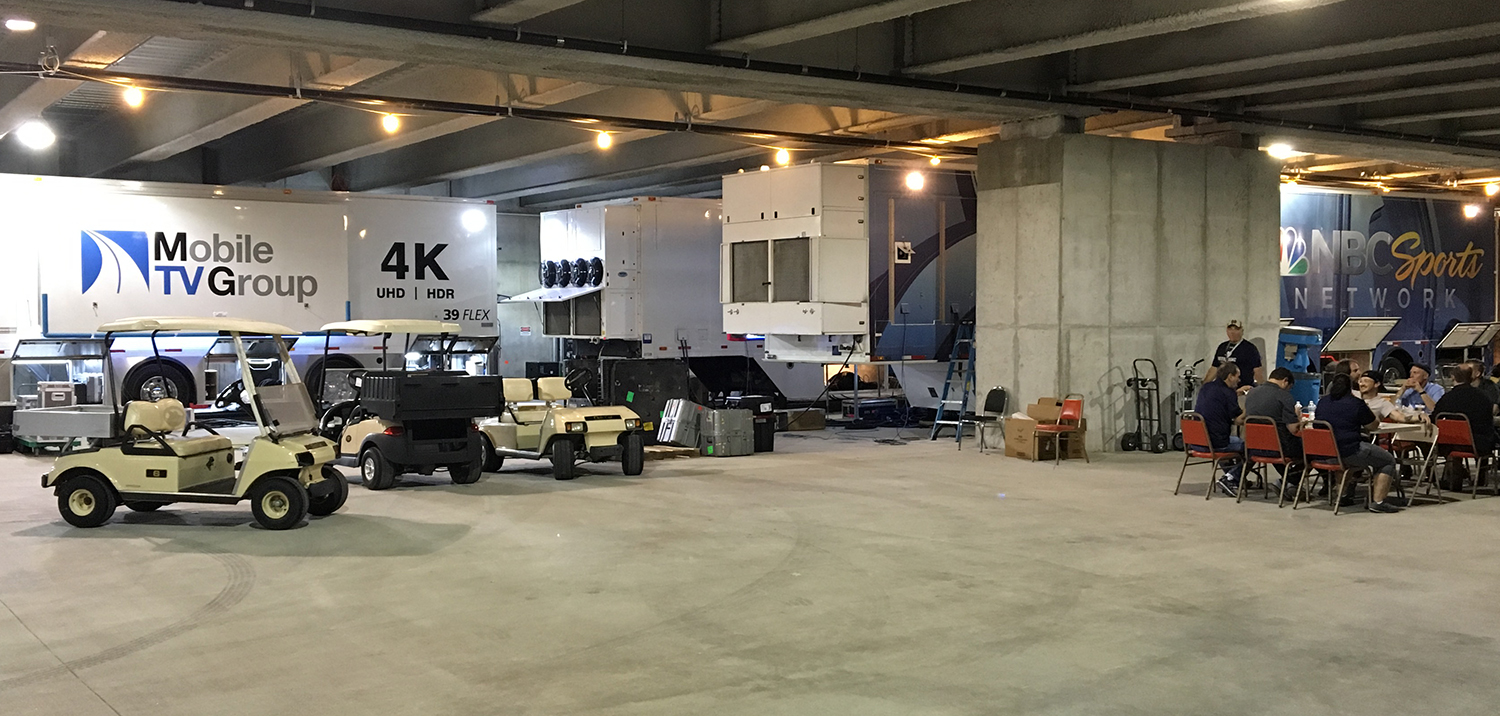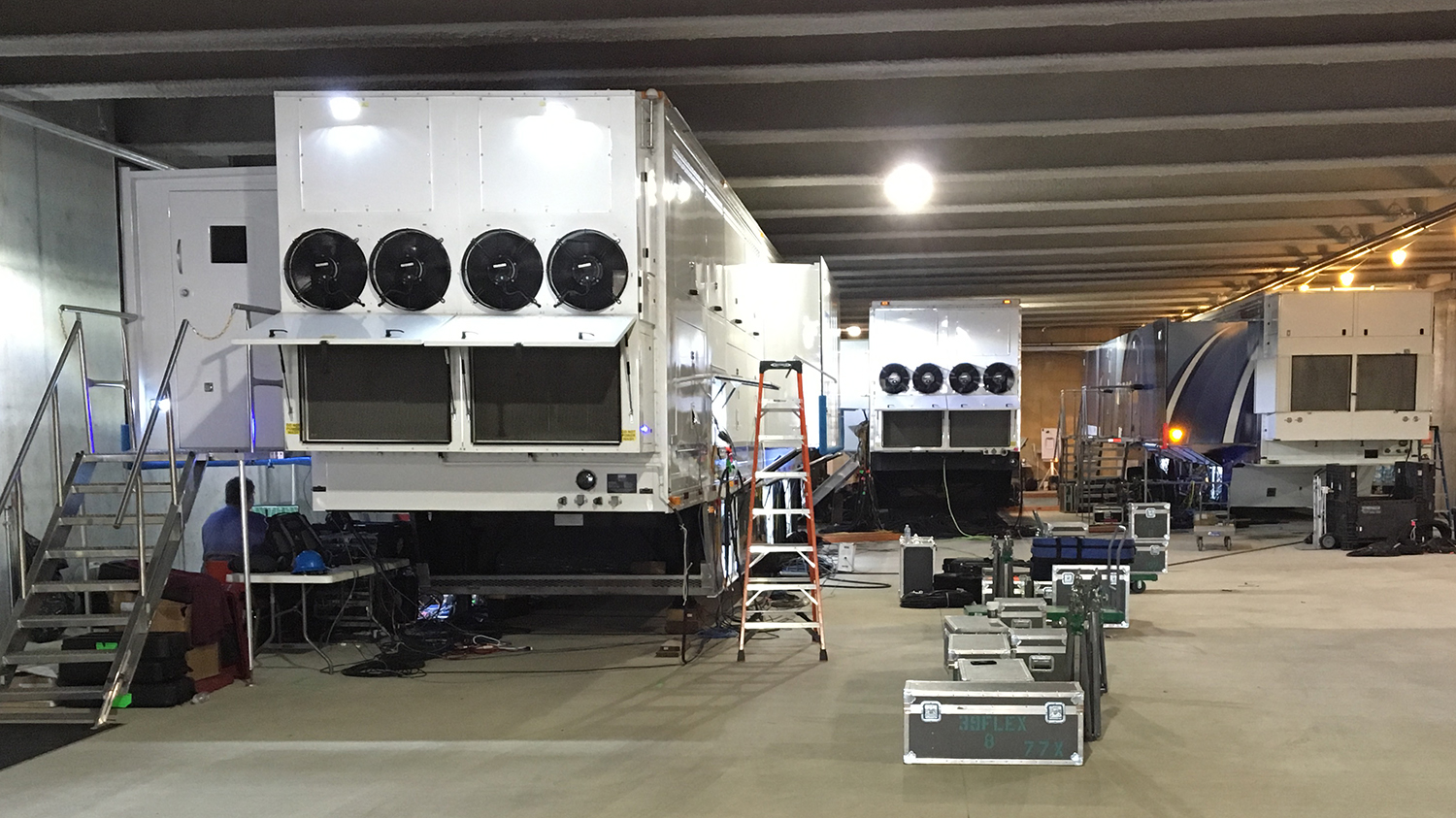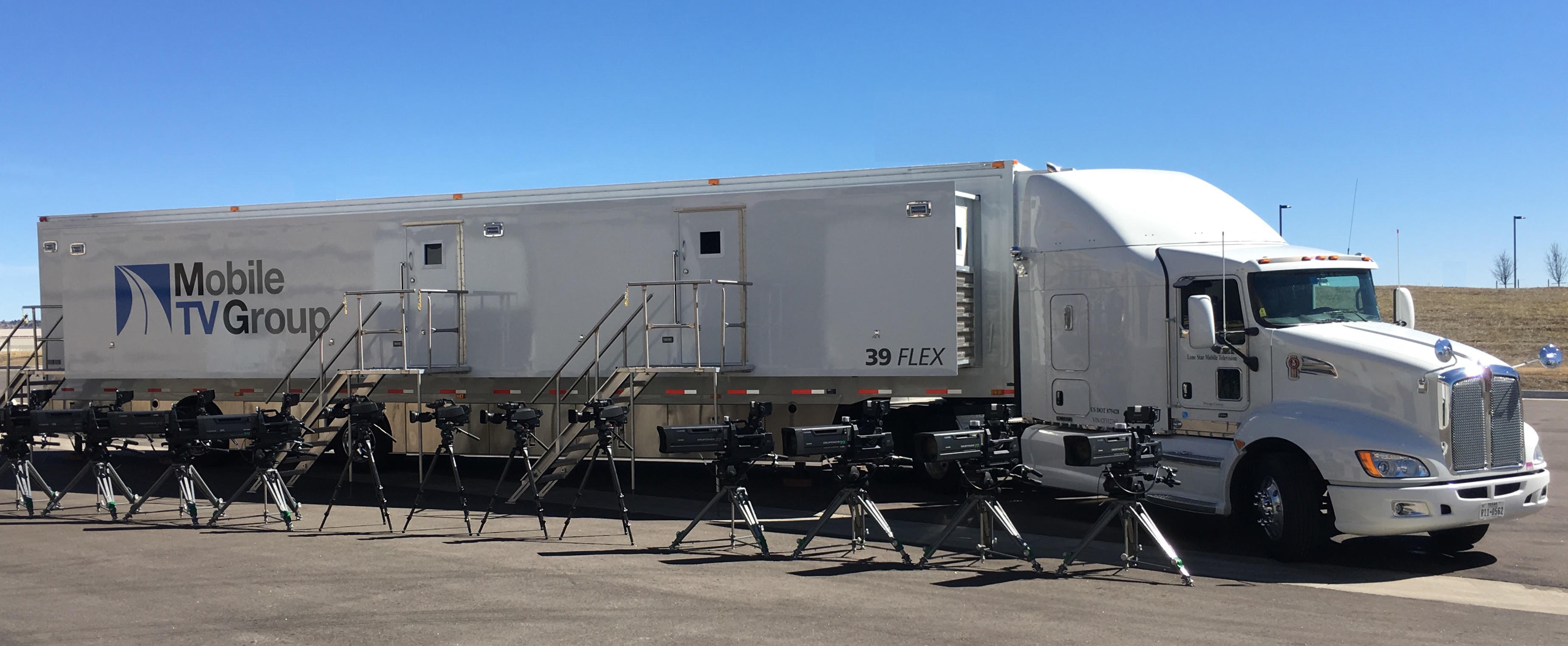Inside NBC Sports Group’s Historic Notre Dame 4K/UHD Productions
Here’s a behind-the-scenes look at the first-ever multigame football package produced in 4K
Story Highlights
The first-ever season of live 4K college football is in the books: NBC Sports Group completed its slate of seven Notre Dame home games last month. The septet of productions in South Bend marked the first multigame football package to be produced in 4K and represented a massive commitment to live 4K production by NBC Sports Group and DirecTV, which distributed the games.

The compound at Notre Dame Stadium featured MTVG’s 39 FLEX (left) working the 4K show and NEP’s ND6 (right) for the 1080p show.
“We’re always very big fans of pushing the envelope and doing something to advance broadcasting,” says NBC Sports Director Pierre Moossa. “I think we learned a lot about the workflow and how to be more efficient. Anytime doing something new, there’s a learning curve, but I felt like [the process] could not have gone smoother, and, ultimately, the viewer benefited from it.”
The side-by-side HD and 4K productions used two trucks — Mobile TV Group’s 39 FLEX for the 4K show and NEP’s ND6 for the HD show. Both shows leveraged the same camera complement – primarily Sony HDC-4300’s – with the primary production team of Moossa and producer Rob Hyland in ND6 and a shadow cut produced out of 39 FLEX.
“We embraced the challenge, and it was extremely successful for both NBC and DirecTV,” says Ken Goss, SVP, remote operations and production planning, NBC Sports Group. “This being our first [4K production] and with all the elements included in a Notre Dame broadcast, the side-by-side version was the way to go. We wanted to make sure our HD broadcast was unaffected but, at the same time, [we gave] DirecTV the best 4K product we could. Eventually, the goal is to have a single 4K stream with a 4K truck instead of cutting side-by-side, and that will happen in time.”
A Quick Turnaround From Rio
The decision to produce Notre Games in 4K came in August, leaving NBC Sports Group operations and engineering teams not much time following the conclusion of the Rio Olympic Games.
“When we got back from Rio, we had to figure out how this was going to work rather quickly,” says NBC Sports Group producer Rob Hyland. “Some of the smartest people at NBC put their heads together to figure out how we could do a side-by-side production of both the NBC broadcast and a 4K production.
“Honestly, at first, I was pretty hesitant knowing all of the ‘oh by the ways’ that could go along with something like this,” he continues. “But, our first game of the season, which was against Nevada, couldn’t have gone any smoother. And our technical staff and production staff and engineers made what could have been a very difficult process a much more transparent process, and I couldn’t be happier with how it all went.”
The Move to 4K: Made Possible by the Move to 1080p
NBC worked with NEP to convert ND6 (one of the mobile units used for NBC’s NHL coverage) from 1080i to 1080p because “that made the process and the workflow that much simpler,” according to Goss.
In order to convert ND6 to 1080p, NEP added a significant amount of 3G infrastructure and router input/output cards. This required NBC to approach every single vendor used on Notre Dame productions to ensure that its products were 1080p-capable. In addition, the NBC graphics team had to upconvert the entire Notre Dame graphics package to 1080p.
“Going into it, you think you’re just going to flip a switch, and the signal will just be how we need it,” says Craig Bernstein, senior director, remote technical operations and engineering, NBC Sports Group. “But, in reality, it was a massive effort to get [vendors] like SMT and Sportvision and others on the right format. One of the other big things we struggled with was figuring out how to transcode our graphics to 1080p easily without telling the graphics department that they have to do hundreds of hours’ worth of work to replicate everything for us. It took us a while to figure that out, which ended up being an EVS solution, but we were able to get creative and work all of this out.”
Inside the 1080p/4K Workflow
The side-by-side production deployed 14 Sony HDC-4300 4K/high-speed/HD cameras, with 12 CCUs outputting dual 4K and 1080p feeds to routers in 39 FLEX and ND6, respectively. The two additional 4300’s were in 6X high-speed mode (not 4K) and routed directly into ND6 before being upconverted to 4K in 39 FLEX. In addition to the high-speed–camera positions, POVs, and the Skycam were in native HD and upconverted for the 4K feed.
No camera positions were sacrificed to create the 4K show, because NBC’s Notre Dame home-game complement matched its complement for away games, which were not produced in 4K.
Moossa and Hyland were in ND6 producing the primary HD show, while a separate technical director in 39 FLEX listened in to Moossa’s cutting the show and produced a shadow-cut for the 4K feed.
“The only shared resource in the truck was our video operation in 39 FLEX, which benefited obviously from the higher-quality 4K lenses and cameras when shading the cameras,” says Moossa. “But, otherwise, a small crew in 39 FLEX essentially shadowed everything we did on the HD broadcast.”
All graphics were generated in 1080p and then upconverted to 4K for the UHD telecast.
The output of the 4K truck went directly to DirecTV transmission, while the output of the HD truck was downconverted to 1080i and transmitted via NBC.
Minimal Impact on the Front Bench
As more and more 4K productions come to fruition, one thing has become clear: the addition of 4K cannot have any significant impact on the HD production. Earlier innovators like TSN and Sportsnet (working with Dome Productions), MLB Network (Game Creek Video) CBS Sports (Mobile TV Group), have made this a priority in developing their live 4K production models, and NBC was no different.
“There’s always that expectation from production that we’re going be able to pull it off and they’ll feel no pain from it,” says Bernstein. “We were actually able deliver during a seamless experience for production. There was never any instance when they weren’t able to do something due to the 4K element. That was our goal going into it.”
Hyland seconds that sentiment: “The only time I knew that we were even doing a 4K show was when Pierre and I walked out of the truck before or after a game and saw the additional mobile unit and the engineers associated with it. Once we were in ND6, it was completely transparent.”
Challenges Remain for Single-Truck 4K/HD Production
Although the ultimate goal for NBC — and all sports-content producers, for that matter — is to create a single-truck model to produce both the 4K and HD feeds, challenges remain, most notably in regards to replay.
“The biggest challenge right now is definitely replay,” says Bernstein. “EVS is doing a lot of work with their 4K EVS [replay systems], but, right now, when you use a 12-channel machine in 4K, it essentially becomes a two-in/one-out system. When NBC Sports does a big show, we will sometimes have up to 60 channels of replay. So to get all of those [replay sources] in 4K would result in just hundreds of channels. That’s just not feasible on several levels.”
Nonetheless, Bernstein considers the Notre Dame effort a massive leap forward for NBC Sports’ 4K effort.
“I think the [next step for 4K] for NBC isn’t necessarily Sunday Night Football in a single truck, but we can certainly take the lessons we learned from Notre Dame and build a truck that can do something like NHL hockey for us as a full 4K production. I think we took some pretty significant steps forward.”
More Live 4K on the Way?
As for future 4K productions, NBC has yet to officially announce any plans. That said, Goss believes the learnings from the Notre Dame effort have put the Peacock’s production, operations, and engineering teams in position to be ready for whatever 4K plans are thrown at them.
“This was a very positive experience, and the Notre Dame [4K package] was definitely something that we can build on,” he says. “We’ve learned a lot, and we’re looking forward to possibly next year’s Notre Dame or some other show in 4K, so we can take this experience and build on it.”


